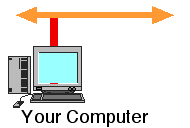

Which operating system does your computer use?
The commands that you will need to type on your computer may be different, depending upon which operating system you may be using. Type:
uname -sr
If you are using a UNIX-based computer, you will see some lines of text describing the operating system. This may be "SunOS", "Darwin", "Linux", "BSD", etc.
If you do not recognise the operating system, or the command is not found. Then you could try typing the following, to see if this is a PC-based operating system:
ver
On a PC, this will tell you the version of the operating system.
Most users will not need the remainder of the details on this page, particularly if you will be using a UNIX-based computer operating system. However, if you do find a particular command does not work, or does not exist, then please do come back to this page and read more.
If you wish to resume the practical exercise immediately CLICK HERE
Normally, the person who set up your computer will have placed the appropriate directories on your "path" and you will only need to type 'ping', 'netstat', etc .
The locations of the commands organised by operating system are shown below:
SUN workstations use a UNIX operating system. The version of UNIX used by most modern SUNs is based upon the System V UNIX originally developed by AT&T.
The commands you will need are to be found in the following locations:
If you have an old SUN, your computer may be running a version of UNIX based on the Berkeley System Distribution (BSD). Although the SunOS 4 UNIX is based on BSD UNIX, the networking commands are stored in a different place under SunOS 4.
On a SunOS 4.X UNIX system, the commands are to be found in the following locations:
Your computer may be a PC, Mac, or other computer running a version of UNIX based on Linux.
On a Linux system, the commands are to be found in the following locations:
Your computer may be a PC, or other computer running a version of UNIX based on FreeBSD.
On a FreeBSD system, the commands are to be found in the following locations:
Computers using MacOS X also use a version of UNIX. To type UNIX commands, you first launch a "Terminal Tool" from the applications/utlities folder, this gives you a standard UNIX terminal in which you can type commands.
The commands are to be found in the following locations:
A PC using a Windows operating systemis not based on UNIX, but does support some of these commands. Before you use these commands on a PC you must first launch a "command tool" by clicking on Start -> Run and type 'command' (on Windows 98) or 'cmd' on (Windows XP). If you have an account on a UNIX system, then you can do all the activities in this exercise by following the instructions in the next section on "other operating systems".
All the commands are to be found in the following location:
You can also log on to a remote workstation, and then you may directly type in a window. If you are using a PC, you may first have to logon to the PC and then type "rlogin", "telnet", or open a terminal window (all are equivalent for this exercise) to connect to a UNIX workstation. Once you have a window open connected to the remote computer, you should follow the instructions above that are appropriate to the operating system of the computer to which you have connected.
Click here to resume the practical exercises
http://www.erg.abdn.ac.uk/users/gorry Date: 10/11/1995 Revised: 7/10/2003